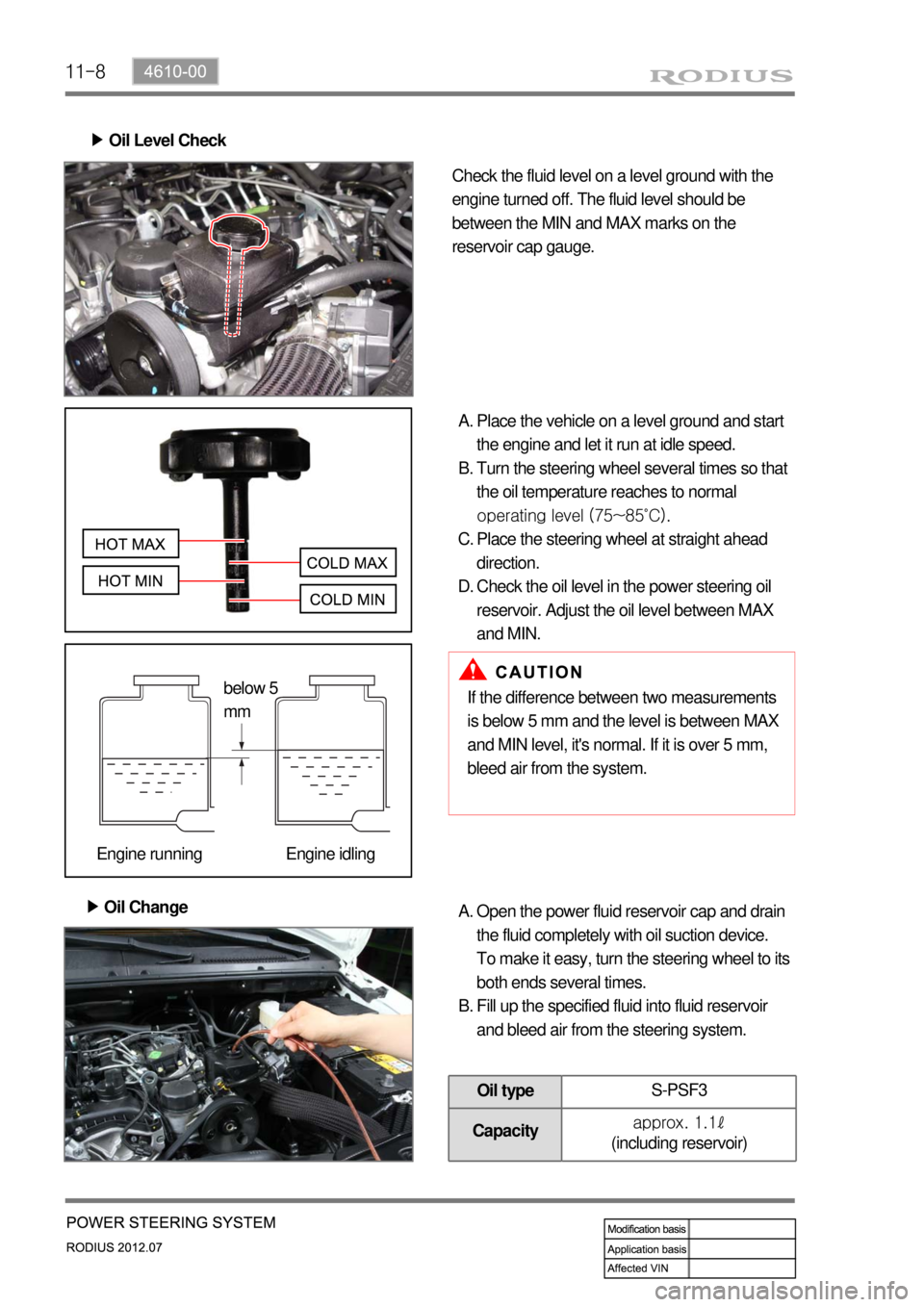Page 527 of 715
01-8
3. TIGHTENING TORQUE
Description Tightening Torque (Nm) Remark
Oil drain plug (oil pan) 14 Hexagon, 5 mm
Oil filler pipe (upper) 8 ~ 10 -
Oil filler pipe (lower) 8 ~ 10 -
Oil cooler pipe 30 ~ 38 -
Oil pan 8 T 30
Torque converter housing/oil pump 20 -
Transmission rear mounting bracket
(left/right)36 ~ 44 -
Transmission rear mounting bracket
(center)20 -
Torque converter mounting bolt 42 -
Converter housing/engine 75 ~ 90 -
Converter housing/transmission housing 20 T 45
Valve body 8 T 30
Valve body side cover 4 T 30
Solenoid valve 8 -
12-point collar nut 200 12-point, 30 mm
B2 housing bolt 16 T 45
Selector lever unit mounting bolt 6 -
Page 568 of 715
03-113010-00
3. DUAL MASS FLYWHEEL (DMF)
The dual mass flywheel (DMF) is of having a mass divided into two halves.
While one mass is connected to the engine crankshaft, which is affected by the mass moment of
inertia of the engine, the other mass is affected by one of the transmission.
The divided dual masses are connected to the coil spring and damping system internally.
The DMF has the following benefits: ▶
Reducing fuel consumption by lowering engine speed
Reducing rattling noise and vehicle vibration in all driving ranges
Reducing synchronization wear
Facilitating gear change
Protecting power train parts by preventing excessive load from being delivered -
-
-
-
-
Primary flywheel
Secondary flywheel
Arc damper spring
Torque limiter
Ring gear 1.
2.
3.
4.
5.
Page 569 of 715
04-34120-01
1. SPECIFICATIONS
Front Axle ▶
Rear Axle ▶
Description Specification
Drive shaft type CV joint
Axle housing type Build up
DifferentialType Conventional type
Gear type Hypoid Gear
Final gear reduction ratioEngine + M/T 3.54
Engine + A/T 4.55
OilCapacity 1.2L
Specification SAE 80W / 90
Description Specification
Axle shaft type Semi-floating
Axle housing type Build up
DifferentialType Conventional type
Gear type Hypoid Gear
Final gear reduction ratioEngine + M/T 3.54
Engine + A/T 4.55
OilCapacity 1.7L
Specification SAE 80W / 90
Page 646 of 715

11-8
Oil Level Check ▶
Check the fluid level on a level ground with the
engine turned off. The fluid level should be
between the MIN and MAX marks on the
reservoir cap gauge.
Place the vehicle on a level ground and start
the engine and let it run at idle speed.
Turn the steering wheel several times so that
the oil temperature reaches to normal
operating level (75~85˚C).
Place the steering wheel at straight ahead
direction.
Check the oil level in the power steering oil
reservoir. Adjust the oil level between MAX
and MIN. A.
B.
C.
D.
Oil Change ▶
If the difference between two measurements
is below 5 mm and the level is between MAX
and MIN level, it's normal. If it is over 5 mm,
bleed air from the system.
Open the power fluid reservoir cap and drain
the fluid completely with oil suction device.
To make it easy, turn the steering wheel to its
both ends several times.
Fill up the specified fluid into fluid reservoir
and bleed air from the steering system. A.
B.
Oil typeS-PSF3
Capacityapprox. 1.1ℓ
(including reservoir)
below 5
mm
Engine running Engine idling
Page 647 of 715
11-94610-00
Air Bleeding ▶
The air bleeding should be done after servicing the
power steering system and when the difference
between two measurements (cooled and normal
temperature) is prominent.
Normal AbnormalLift up the vehicle very carefully.
Turn the steering wheel to its both ends
several times and add the oil up to MAX line
in the steering oil reservoir.
Periodically crank the starting motor and turn
the steering wheel to its both ends without
any interruption.
Check the oil level again. If the oil level is
fluctuated, repeat the procedures from step 3
to step 5.
Start the engine.
Turn the steering wheel to its both ends until
any bubble can be found in the steering oil
reservoir.
Perform the test drive and check the steering
wheel for normal operation and noise.
If the oil level abruptly goes up, bleed the air
from the system again. A.
B.
C.
D.
E.
F.
G.
H.
If the air bleeding is not properly performed,
the life span of the power steering pump may
be shortened. -
Page 648 of 715
11-10
Oil Pump Pressure Check ▶
Check the oil pump pressure to locate any defect
in oil pump.
Before checking the pressure, check the oil
level and belt tension. Prepare the empty
container to collect the spilled oil during the
service.
Unscrew the pressure line fitting in power
steering pump.
Install the pressure gauge between the
power steering pump and the power steering
oil pressure line.
Place the shift lever to neutral position. Apply
the parking brake.
Open the valve in pressure gauge. Start the
engine and let it run at idle speed.
Turn the steering wheel several times so that
the oil temperature reaches to normal
operating level. A.
B.
C.
D.
E.
Fully close the valve in pressure gauge and
measure the oil pressure. F.
To prevent internal damage, do not close the
gauge valve over 10 seconds.
Keep the oil temperature at proper range. -
-
Relief pressure90 ± 3 bar
Page 649 of 715
11-114610-00
Measure the oil pressure with the gauge valve
fully open. G.
Pressure at no load3 ~ 5bar
If the pump pressure is in specified range, the
pump is normal. If not, replace the power
steering pump H.
Turn the steering wheel righ or left until it
stops with the engine idling ans valve fully
open. I.
Oil pressure78 ~ 83bar